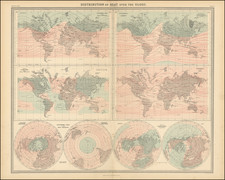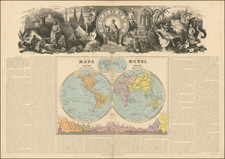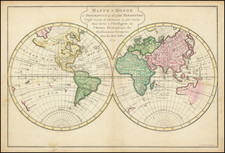Attractive Pair of Screen Maps Showing the World (after Matteo Ricci) and Japan.
The map of Japan is extensively annotated with place names and listings of the provinces and their revenues. The provinces are clearly defined by borderlines and different colors, some areas showing dense forests or mountain ranges with red lines denoting the major routes both by land and water. It is made in the Gyōki style. It was the style for cartographic portrayal of the Japanese islands before the arrival of the Europeans, and later maps of Japan depended largely on this original work up to and during the Edo period. Gyōki-Bosatsu was a Buddhist monk (668-749), who is credited with the creating of this style of map, even though there is no evidence that he ever did.
Jason Hubbard says:
A Gyōki-type map shows the three main islands of Japan, excluding Hokkaido, divided into sixty-six kuni [fiefs], and an attempt is made to show the size difference in each ... Gyōki-type maps are chorographic representations intending to show the relative position and size of the provinces and, in a number of cases, the main roads. They do not contain a scale although some give an indication of travel time between points on the map. This type of depiction survived for centuries, even after Japanese mapmakers knew how to make more accurate maps. They became stereotyped, as was common with so many other aspects of the arts in Japan.
The large maps mounted on screens might have had an educational use but they would also have been objects of curiosity and decoration as well as conversation pieces.
Japan: Six-fold screen with a map of Japan with geographical inscriptions, ink, and color on buff ground, (1110 x 2870mm.), a few minor repairs or areas of loss












![[The centre of this Slider is to be placed by a Thread or Pin over the centre of the respective Planisphere for any Operation]](https://storage.googleapis.com/raremaps/img/small/65557.jpg)



